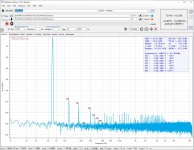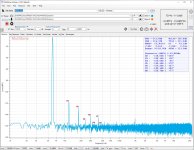Marcel,
For ES9039Q2M, the digital path for DSD is shown as somewhat different from PCM:

For ES9038Q2M the output filter for DSD is shown as:

Whatever ESS does with DSD does seem to be different from what it does to process PCM. Also, it is shown in the attached paper that a FIR filter can be directly applied to a DSD stream. More info on that in a PhD thesis at: https://kclpure.kcl.ac.uk/ws/portalfiles/portal/2925464/387587.pdf
Another paper at: https://www.aes.org/e-lib/online/browse.cfm?elib=8443
For ES9039Q2M, the digital path for DSD is shown as somewhat different from PCM:
For ES9038Q2M the output filter for DSD is shown as:
Whatever ESS does with DSD does seem to be different from what it does to process PCM. Also, it is shown in the attached paper that a FIR filter can be directly applied to a DSD stream. More info on that in a PhD thesis at: https://kclpure.kcl.ac.uk/ws/portalfiles/portal/2925464/387587.pdf
Another paper at: https://www.aes.org/e-lib/online/browse.cfm?elib=8443
Attachments
Last edited:
It is shown in the attached paper that a FIR filter can be directly applied to a DSD stream.
That’s exactly what a Firdac is doing, isn’t it ?
Hans
P.s. I didn’t want to go through 325 pages.
To which pages are you referring
That’s exactly what a Firdac is doing, isn’t it ?
Hans
P.s. I didn’t want to go through 325 pages.
To which pages are you referring
Last edited:
Hans,
The thesis was one of the references in the AES paper, but as it turns out not the one I wanted. Too late to edit the post though.
There have have been a few other papers on the subject of DSD effects processing, but some may have become extinct. Mainly what exists that I could find is in three AES papers. Of those, I only have the one. However there is also this: https://www.researchgate.net/public...rnary_FIR_filter_using_sigma_delta_modulation
Perhaps interestingly, IIRC some of the one-cycle control literature references one of the AES DSD papers. Also, there is this: https://ieeexplore.ieee.org/document/5489382
Anyway, the ESS single-bit FIR filter appears to allow volume control without conversion to PCM. At least that seems to be what is implied by the ESS diagram and by the fact that they show a different filter for DSD than is used for PCM. Those sorts of things might suggest the types of differences that could allow ESS dacs to perform better in DSD mode.
Mark
The thesis was one of the references in the AES paper, but as it turns out not the one I wanted. Too late to edit the post though.
There have have been a few other papers on the subject of DSD effects processing, but some may have become extinct. Mainly what exists that I could find is in three AES papers. Of those, I only have the one. However there is also this: https://www.researchgate.net/public...rnary_FIR_filter_using_sigma_delta_modulation
Perhaps interestingly, IIRC some of the one-cycle control literature references one of the AES DSD papers. Also, there is this: https://ieeexplore.ieee.org/document/5489382
Anyway, the ESS single-bit FIR filter appears to allow volume control without conversion to PCM. At least that seems to be what is implied by the ESS diagram and by the fact that they show a different filter for DSD than is used for PCM. Those sorts of things might suggest the types of differences that could allow ESS dacs to perform better in DSD mode.
Mark
Last edited:
Mark,
A bit offline.
I had a look at the hugely complicated SA-10 that you posted.
The “never use a feedback cap when using CFA’s rule” was ignored to my surprise.
But even more surprisingly were numerous reviews going from the worst price/performance machine ever tested up to the best sounding DAC ever heard. 🤣
Hans
A bit offline.
I had a look at the hugely complicated SA-10 that you posted.
The “never use a feedback cap when using CFA’s rule” was ignored to my surprise.
But even more surprisingly were numerous reviews going from the worst price/performance machine ever tested up to the best sounding DAC ever heard. 🤣
Hans
Actually, I heard one. On the same system, optical vinyl was preferred by everyone present at the time.
That wasn't the point though. It was just that the dac structure itself looked to have some partial similarity to Marcel's RTZ dac. It was to illustrate that some high end audio gear companies have been moving away from chip dacs. It was AKM that maybe got hit hardest by that. Most of the AK4499EQ chips they made seemed to end up in mainstream consumer market Chinese dacs.
Regarding reviews for SA-10, not surprising ASR wouldn't rate it that great. However we know that SQ is not simply about AP measurements, and AP knows it too.
That wasn't the point though. It was just that the dac structure itself looked to have some partial similarity to Marcel's RTZ dac. It was to illustrate that some high end audio gear companies have been moving away from chip dacs. It was AKM that maybe got hit hardest by that. Most of the AK4499EQ chips they made seemed to end up in mainstream consumer market Chinese dacs.
Regarding reviews for SA-10, not surprising ASR wouldn't rate it that great. However we know that SQ is not simply about AP measurements, and AP knows it too.
Last edited:
Marcel,
For ES9039Q2M, the digital path for DSD is shown as somewhat different from PCM:
View attachment 1210952
For ES9038Q2M the output filter for DSD is shown as:
View attachment 1210953
Whatever ESS does with DSD does seem to be different from what it does to process PCM. Also, it is shown in the attached paper that a FIR filter can be directly applied to a DSD stream. More info on that in a PhD thesis at: https://kclpure.kcl.ac.uk/ws/portalfiles/portal/2925464/387587.pdf
Another paper at: https://www.aes.org/e-lib/online/browse.cfm?elib=8443
It looks to me like they simply low-pass filter the DSD, thereby changing it into high sample rate PCM, and then pass it through the normal signal path except for the two interpolating filters in the bottom left corner. So apparently it is not the modulator then, but the filters in the bottom left corner?
Maybe so. IIUC some people have bypassed those filters and used HQ Player to do the upsampling/interpolation for 16/44 tracks.
Also could be that the processing in the lower left corner is clocked with BCLK and or LRCK, which if jittery may couple some clock noise into later processing. Maybe that's why some people say master mode sounds best?
Also could be that the processing in the lower left corner is clocked with BCLK and or LRCK, which if jittery may couple some clock noise into later processing. Maybe that's why some people say master mode sounds best?
Last edited:
This may well be to reason. Anyhow the difference is quite clear as shown in attached measurements.It looks to me like they simply low-pass filter the DSD, thereby changing it into high sample rate PCM, and then pass it through the normal signal path except for the two interpolating filters in the bottom left corner. So apparently it is not the modulator then, but the filters in the bottom left corner?
Attachments
Mark,
Still any progress made with cable termination and 270pF cap at the interlink’s input ?
Hans
Hans,
I have the terminators on RCA plugs which can easily be added or removed from the circuit. However, right now I have list of other stuff to work on for listening tests when I can get people together. I haven't forgotten though.
Mark
I have the terminators on RCA plugs which can easily be added or removed from the circuit. However, right now I have list of other stuff to work on for listening tests when I can get people together. I haven't forgotten though.
Mark
Hans,
Just to let you know how its going so far, my own impression of the terminator sound is that loses too much 'air' in the final audio reproduction. OTOH, there may be too much air and some other RF junk getting in without a terminator of some type. The problem as I perceive at this point is that the subjective effect of the terminator is excessive. In terms of effect, somewhere in the middle might just about right. What I would like to have might be dubbed a 'Goldilocks' terminator.
Mark
Just to let you know how its going so far, my own impression of the terminator sound is that loses too much 'air' in the final audio reproduction. OTOH, there may be too much air and some other RF junk getting in without a terminator of some type. The problem as I perceive at this point is that the subjective effect of the terminator is excessive. In terms of effect, somewhere in the middle might just about right. What I would like to have might be dubbed a 'Goldilocks' terminator.
Mark
Thx for your feedback.
You could change the termination from 1n+100R to 470pF+100R.
The other thing that I could advice in all cases when not already done is to remove the 270pF.
Hans
You could change the termination from 1n+100R to 470pF+100R.
The other thing that I could advice in all cases when not already done is to remove the 270pF.
Hans
You can try my media player, it has an ABCDE/X player. Use my debian repo https://t-5.eu/hp/Software/Debian repository/ and install mediaui. beware that this is normally not intended for the public as it has highly specific features that only cater my needs 🙂Sure, do you know a good ABX tool for Linux?
Hi Mark, what sort of transformer are you using, what impedance drives it and have you damped it correctly?There are a pair of transformers at the input to the line amp. They are essentially part of the line amp.
DAC Analog output from dac board -> DC blocking caps -> non-uniform directional cable of some length as needed -> RCA input connector on line amp -> transformer on line amp PCB -> amplifier active electronics -> ...
Also, I am okay with ordering some of those three way RCA connectors from Amazon. Could take a few day, have to see.
I'm surprised you are using a transformer, some time ago you were against them, what changed?
Thanks,
Terry
Terry,
Transformers are unobtainium and NDA, is all I can say for now. I see hopeful signs it may not be too much longer (in terms of weeks) before I might be able to say more. Don't know exactly.
Mark
Transformers are unobtainium and NDA, is all I can say for now. I see hopeful signs it may not be too much longer (in terms of weeks) before I might be able to say more. Don't know exactly.
Mark
- Home
- Source & Line
- Digital Line Level
- Return-to-zero shift register FIRDAC

